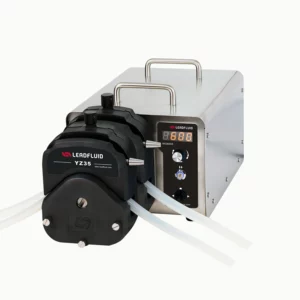While industrial intelligent dispensing peristaltic pumps offer many advantages, they also have limitations that users should be aware of.
Some of these limitations include:
- Viscosity Constraints: Peristaltic pumps are generally better suited for low to medium viscosity fluids. Highly viscous fluids, such as pastes, gels, or high-density liquids, may pose challenges for peristaltic pumps due to limitations in flow rate and pumping efficiency.
- Limited Pressure Capability: Peristaltic pumps typically operate at relatively low pressure compared to other types of pumps. This can limit their suitability for applications requiring high-pressure dispensing, such as certain industrial processes or hydraulic systems.
- Flow Rate Variability: While peristaltic pumps offer precise control over flow rates, they may exhibit variability in flow rates when pumping certain fluids, especially those with irregular consistency or particulate matter. This variability can affect dosing accuracy and consistency in some applications.
- Tube Compatibility: Peristaltic pumps rely on flexible tubing to transport fluids, and the compatibility of the tubing with the pumped fluid is crucial. Some fluids may degrade or react with the tubing material, leading to premature tubing failure or contamination of the pumped fluid.
- Limited Suction Lift: Peristaltic pumps have limitations in their ability to lift fluids from a lower level or suction from a reservoir. The suction lift capability of peristaltic pumps is typically lower compared to other pump types, which may restrict their use in certain applications.
- Maintenance Requirements: Peristaltic pumps require regular maintenance, including tubing replacement, cleaning, and inspection of pump components. Failure to perform adequate maintenance can lead to premature wear, reduced performance, and potential downtime.
- Cost Considerations: Industrial intelligent dispensing peristaltic pumps may have higher upfront costs compared to conventional pumps, especially for models equipped with advanced features such as automation, programmability, and monitoring capabilities.
- Limited Solvent Compatibility: Some solvents or aggressive chemicals may not be compatible with the materials used in peristaltic pump components, such as tubing, rollers, and seals. Compatibility testing is necessary to ensure safe and reliable operation with specific fluids.
- Size and Portability: Industrial peristaltic pumps, especially those designed for high-flow or high-pressure applications, can be large and heavy. This may limit their suitability for portable or space-constrained environments.
- Complexity of Operation: While intelligent dispensing peristaltic pumps offer advanced features for automation and control, they may also require a certain level of technical expertise to set up, program, and operate effectively. Training and familiarization with the pump’s interface and software may be necessary for users.
Despite these limitations, industrial intelligent dispensing peristaltic pumps remain valuable tools for precise and controlled fluid dispensing in a wide range of industrial, laboratory, and research applications. Understanding these limitations can help users make informed decisions when selecting and using peristaltic pumps for their specific requirements.
